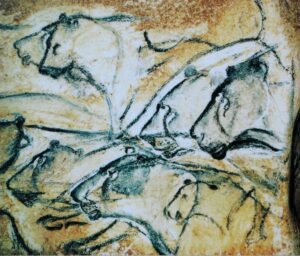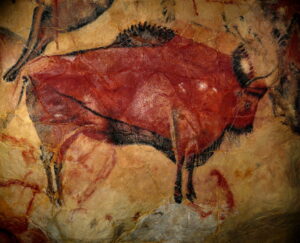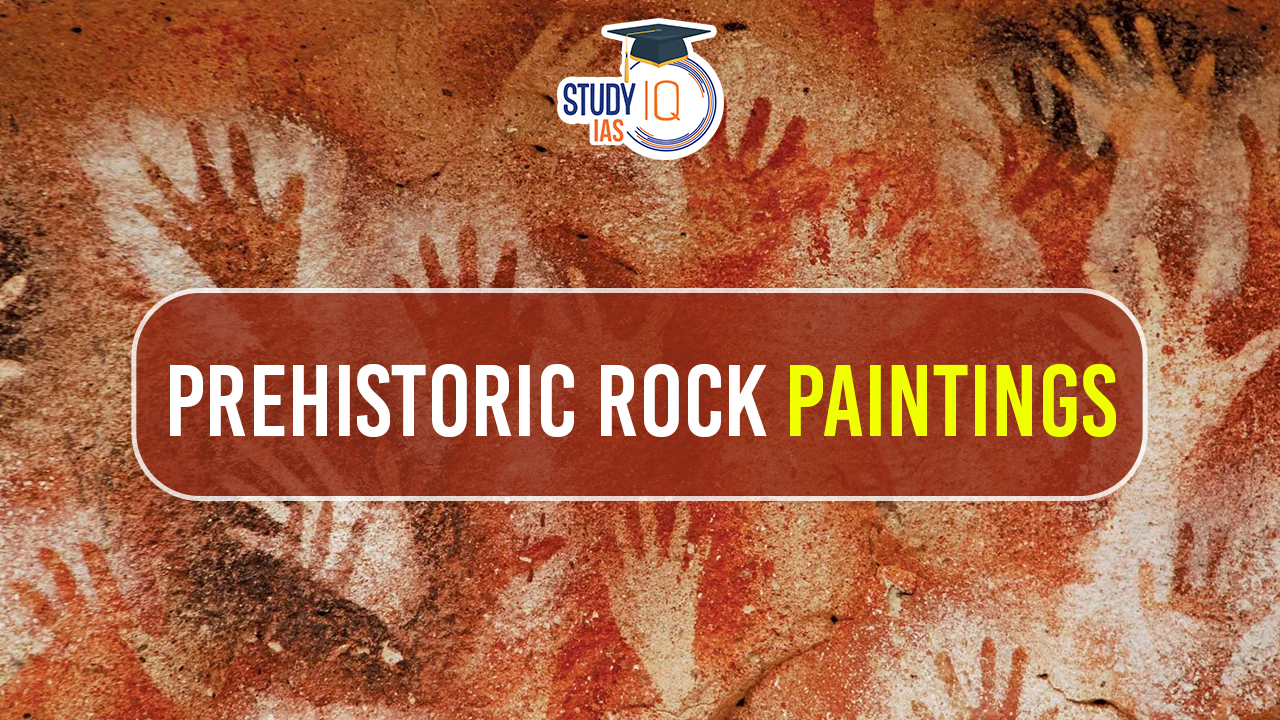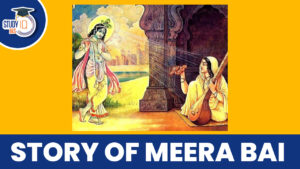Table of Contents
Prehistoric Rock Paintings
Petroglyphs are the name given to prehistoric rock carvings that were typically painted on rocks. The Bhimbetka caves in Madhya Pradesh are where the earliest prehistoric artwork were discovered. The earliest forms of art that people used to express themselves on a cave wall as a canvas were paintings and sketches. In order to prepare for the UPSC Civil Service Exam, you can use this article to understand the ideas around the Prehistoric Rock Paintings.
Prehistoric Rock Paintings Background
The sketches and paintings can be used to identify seven historical eras. In 1957–1958, archaeologist V.S. Wakankar found the Bhimbetaka paintings. These paintings frequently include tigers, bison, and other big game creatures. Because they feature elephants, rhinoceroses, cattle, snakes, spotted deer, barasingha, and other creatures, they are known as the “Zoo Rock Shelter.” Three significant phases can be identified in prehistoric paintings:
- Palaeolithic Period
- Mesolithic Period
- Chalcolithic Period
Upper Palaeolithic Period (40000–10000 BC)
Minerals were used as paints since the walls of the rock shelter caves were made of quartzite. One of the most common minerals was ochre, also known as geru, when combined with lime and water. By adding other minerals to their colour palette, they were able to produce hues like red, white, yellow, and green.
White, dark red, and green were used to depict large animals like bison, elephants, rhinos, tigers, and others. In human sculptures, red was typically utilised for hunters and green for dancers. In Madhya Pradesh, Uttar Pradesh, Andhra Pradesh, Telangana, Karnataka, Bihar, and Uttarakhand in India, remnants of rock paintings have been found on cave walls.
Early rock painting sites include Lakhudiyar in Uttarakhand, Kupgallu in Telangana, Piklihal and Tekkalkotta in Karnataka, Bhimbetka and Jogimara in Madhya Pradesh, among others. These paintings fall into three categories: Man, Animal, and Geometric Symbols.
Upper Palaeolithic Period Features
The human form is portrayed as a stick figure. A long-snouted animal, a fox, and a multi-legged lizard are typical animal motifs in the early paintings (many other creatures were later created). There are more wavy lines, geometric patterns filled with rectangles, and a cluster of dots.Beginning with black, moving through crimson, and ending with white, paintings are layered one on top of the other. One of India’s and the world’s oldest paintings, dating to the Upper Palaeolithic, is Bhimbetka.

Mesolithic Period (10000–4000 BC)
The era with the most artistic remains is the Mesolithic. There are many themes, however the paintings are small. Most of the scenes feature hunters. Groups of hunters used bows, arrows, pointed sticks, and barbed spears. Traps and snares used to catch animals are depicted in certain paintings.
A common past time for Mesolithic inhabitants was animal pointing. In some images, mankind are being chased by animals, while in others, they are being chased by hunters. Throughout this time period, red was frequently used. Compared to the Upper Palaeolithic Period, the size of the paintings decreased at this time. One of the most frequent scenes depicted in these paintings is group hunting, and several others show grazing and riding activities.
Chalcolithic Period
During this time, there were a rise in the amount of paintings that featured the colours green and yellow. Most of the paintings are representations of combat situations. Many artworks show men astride horses and elephants. Some of them are equipped with bows and arrows, showing that they are prepared for battle. The idea that man perfected the art of tanning skins for clothing and shelter is supported by the drawings of spotted deer skins drying.

Other pieces of art from this historical period also feature musical instruments like the harp. In several of the paintings, intricate geometrical forms like the spiral, rhomboid, and circle are seen. Some paintings from the later era can be found at the Jogimara caves in the Ramgarh hills in the Surguja district of Chhattisgarh. These were allegedly painted about the year 1000 BCE. Caves like the sanctuary of Udkuda, Garagodi, Khaperkheda, Gotitola, Kulgaon, and others may be found in the Kanker region of Chhattisgarh.
These shelters have images of a more affluent and stationary way of life, including human figurines, animals, palm prints, bullock carts, and other objects. Similar paintings can be seen at the Ghodasar and Kohabaur rock art locations in the Koriya district. Another remarkable site is Chitwa Dongri (Durg district), where we can observe murals of dragons, agricultural themes, and a Chinese figure riding a donkey.
Prehistoric Rock Paintings Significance
The colours utilised included white, yellow, orange, red ochre, purple, brown, green, and black. However, white and crimson were their preferred hues. These people used a variety of coloured pebbles to smash to create their paints. They turned red due to haematite (Geru in India). This green shade was achieved using the green rock chalcedony. White was most likely created by limestone.
Sticky substances like animal fat, gum, or tree resin may be used when combining rock powder with water. The brushes were made of plant fibre. These hues are assumed to have been preserved for thousands of years by the chemical reaction of the oxide that exists on the surface of rocks. There have been paintings found in both active and inactive caves. It implies that these pieces of art have occasionally served as signals, warnings, or other comparable functions.
Many of the new rock art locations feature earlier paintings that have been painted over. At Bhimbetka, paintings are visible stacked one over the other in about 20 layers. It shows how humanity has evolved over time, from one era to the next. In symbology, inspiration from nature is blended with a touch of mystical. Only a few illustrations are utilised to convey ideas (the stick-figure drawings symbolise males). There are several geometrical designs. The majority of the scenes included both hunting and depictions of people’s social and economic situations. There are various figures, including carts, chariots, humans, animals, and legendary monsters. Red and white are more significant colours.


 UPSC CMS Admit Card 2025 Out: Download L...
UPSC CMS Admit Card 2025 Out: Download L...
 UPSC Study Material for Prelims & Ma...
UPSC Study Material for Prelims & Ma...
 Story of Meera Bai and Her Devotion For ...
Story of Meera Bai and Her Devotion For ...





















